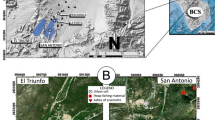Abstract
A potentially high bioavailability of arsenic in gold mine tailings from a site in northern California has been suggested by solubility studies. To help address this issue, an in vivo dosing study was conducted using 12‐day‐old Swiss Webster mouse pups (n=8/group). A sample of size‐fractionated mine tailings from the site (<20 μm particle size, 691 μg g−1 arsenic) was prepared as an aqueous suspension and administered by gavage in a volume that provided 4 mg As/kg body weight. The control group received the same volume of a commercial soil (1 μg g−1 As) of similar particle size (<60 μm). No mortality or toxic signs were noted in either group. Tissue samples were collected 1 h after gavage, freeze‐dried, microwave‐digested and analysed for arsenic by ICP/MS (detection limit 2 ng As g−1 dry weight). Arsenic concentrations (ng As g−1 dry weight) in tissues from the pups who received mine tailings were significantly higher than in control tissues. The mean elevation in arsenic concentration was highest in the liver (3364% of control, p<0.0001), followed by blood (818 of control, p<0.0001), skin (207% of control, p=0.07), and brain (143% of control, p<0.0001). The carcass arsenic concentration (excluding the GI tract, liver, brain and skin) was 138 of control (p=0.02). The data indicate uptake of arsenic from weathered mine tailings by the immature mouse pups after oral exposure.
Similar content being viewed by others
References
Buchet, J., Pauwels, J. and Lauwerys, R.: 1994, Assessment of exposure to inorganic arsenic following ingestion of marine organisms by volunteers. Environmental Research 66, 44-51.
Concha, G., Nermell, B. and Vahter, M.: 1998a, Metabolism of inorganic arsenic in children with chronic high arsenic exposure in Northern Argentina. Environmental Health Perspectives 106, 355-359.
Concha, G., Vogler, G., Nermell, B. and Vahter, M.: 1998b, Low-level arsenic excretion in breast milk of native Andean women exposed to high levels of arsenic in the drinking water. International Archives of Occupational and Environmental Health 71, 42-46.
Davis, A., Ruby, M. V. and Bergstrom, P. D.: 1992, Bioavailability of arsenic and lead in soils from the Butte, Montana, mining district. Environmental Science and Technology 26, 461-468.
Freeman, G. B., Johnson, J. D., Killinger, J. M., Liao, S. C., Davis, A. O., Ruby, M. V., Chaney, R. L., Lovre, S. C. and Bergstrom, P. D.: 1993, Bioavailability of arsenic in soil impacted by smelter activites following oral administration in rabbits. Fundamental and Applied Toxicology 21, 83-88.
Freeman, G. B., Schoof, R. A., Ruby, M. V., Davis, A. O., Dill, J. A., Liao, S. C., Lapin, C. A. and Bergstrom, P. D.: 1995, Bioavailability of arsenic in soil and house dust impacted by smelter activities following oral administration in cynomolgus monkeys. Fundamental and Applied Toxicology 28, 215-222.
Golub, M., Macintosh, M. and Baumrind, N.: 1998, Arsenic developmental toxicity: animal studies and human concerns. Journal of Toxicology and Environmental Health B Critical Reviews 1, 199-241.
Ng, J., Kratzmann, S., Qi, L., Crawley, H., Chiswell, B. and Moore, M.: 1998, Speciation and absolute bioavailability: risk assessment of arsenic-contaminated sites in a residential suburb in Canberra. The Analyst 123, 889-892.
Salocks, C., Hathaway, T., Ziarkowski, D. and Walker, W.: 1996, Physical characterisation, solubility, and potential bioavailability of arsenic in tailings from a former gold mine. The Toxicologist 16, 48.
Vahter, M.: 1983, Metabolism of arsenic, in: B. Fowler (ed.) Environmental effects of arsenic, Elsevier, Amsterdam, pp. 171-198.
Rights and permissions
About this article
Cite this article
Golub, M.S., Keen, C.L., Commisso, J.F. et al. Arsenic tissue concentration of immature mice one hour after oral exposure to gold mine tailings. Environmental Geochemistry and Health 21, 199–209 (1999). https://doi.org/10.1023/A:1006604928479
Issue Date:
DOI: https://doi.org/10.1023/A:1006604928479




